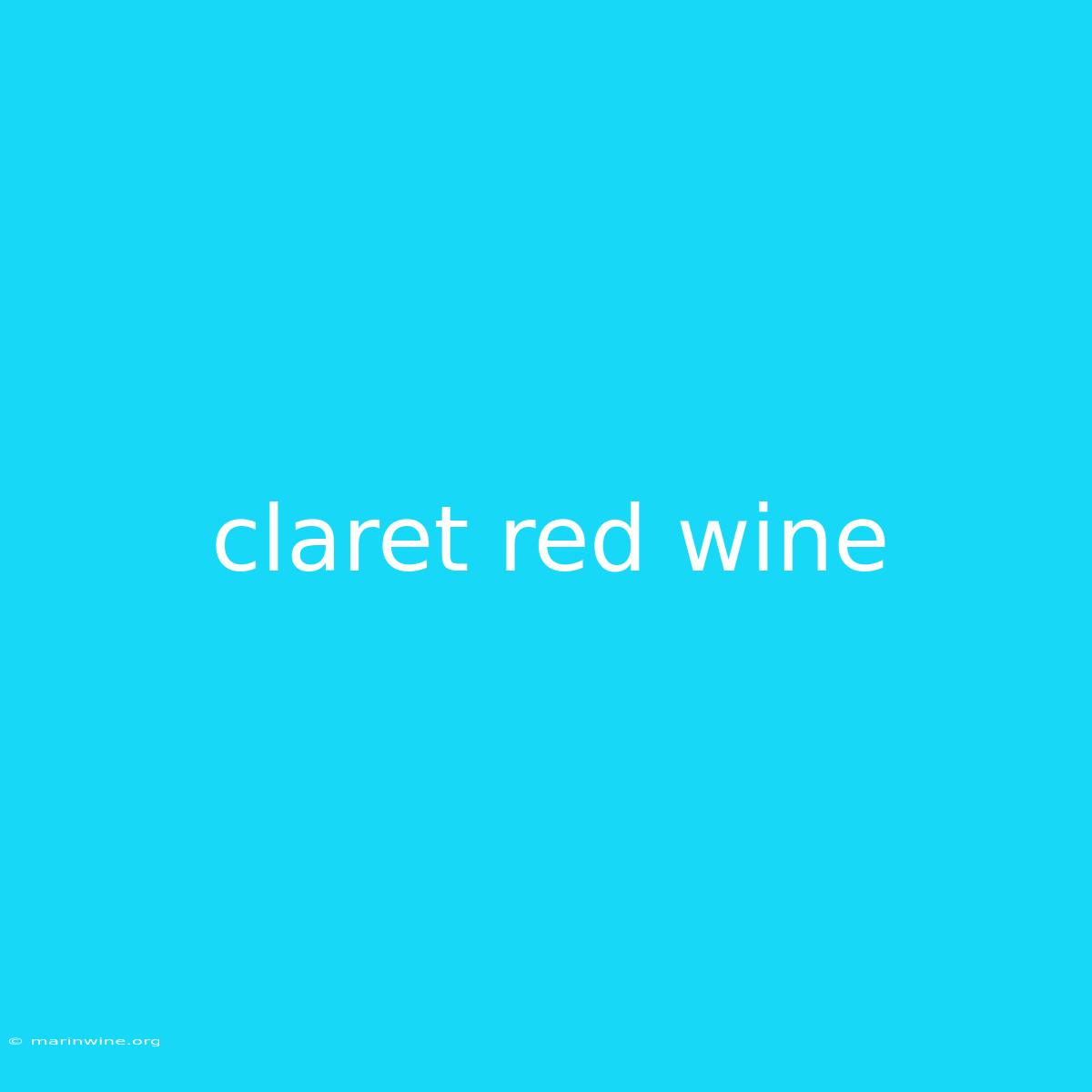Unveiling the Depth of Claret: A Journey into Bordeaux's Red Wine Legacy
Have you ever wondered what makes Claret so special? Beyond its rich, ruby-red hue lies a world of complex flavors and history, making it a true icon of the wine world.
Why This Matters: Claret, a term synonymous with Bordeaux's red wine, holds a unique place in the world of oenology. This article dives into the captivating story behind Claret, exploring its origins, key characteristics, and why it continues to enthrall wine lovers globally.
Key Takeaways of Claret
| Key Takeaway | Description |
|---|---|
| Origin: | Born in Bordeaux, France. |
| Grape Varieties: | Primarily Cabernet Sauvignon, Merlot, Cabernet Franc, and Petit Verdot. |
| Style: | Dry, full-bodied, and often aged in oak barrels. |
| Flavor Profile: | Complex, with notes of black fruit, cedar, tobacco, and spices. |
| Aging Potential: | Many Clarets can age for decades, developing intricate flavors and nuances. |
Claret: A Legacy of Excellence
Claret's history is deeply entwined with the Bordeaux region. The unique terroir, influenced by the Garonne and Dordogne rivers and the Atlantic Ocean, creates ideal conditions for cultivating the grapes that give Claret its distinctive character.
The Heart of Claret: Key Aspects
1. The Blend: The foundation of Claret lies in the art of blending different grape varieties. Cabernet Sauvignon, known for its powerful tannins and structure, dominates most Clarets, adding depth and complexity. Merlot, on the other hand, contributes softness and fruitiness. Cabernet Franc, with its herbal notes, and Petit Verdot, adding color and structure, further enhance the blend's complexity.
2. The Terroir: The unique soils and climate of Bordeaux play a crucial role in Claret's identity. From the gravelly slopes of the Médoc to the clay-rich vineyards of Saint-Émilion, each region contributes distinctive characteristics to the wines.
3. Aging in Oak: The traditional aging process in oak barrels is fundamental to Claret's development. Oak imparts subtle vanilla, spice, and toasted notes, while the tannins soften and integrate with the fruit flavors.
Exploring the Connection: Claret and Terroir
**The impact of terroir on Claret is profound. ** Each sub-region of Bordeaux possesses a unique combination of soil composition, climate, and topography, influencing the character of the wines.
- Médoc: Known for its gravelly soils, the Médoc produces Clarets with robust tannins, powerful structure, and a focus on Cabernet Sauvignon.
- Saint-Émilion: This region's clay-rich soils contribute to softer tannins and richer, more approachable wines with Merlot often playing a dominant role.
- Pomerol: Renowned for its wines with exceptional depth, complexity, and elegance, Pomerol focuses primarily on Merlot.
- Sauternes: While not strictly considered Claret, Sauternes is famous for its sweet, botrytis-affected white wines.
The Connection: Claret and Aging
The aging potential of Claret is a hallmark of its quality. Over time, tannins soften, the fruit flavors develop, and the wine gains an extraordinary depth and complexity.
- Young Claret: Characterized by firm tannins, bold fruit, and vibrant acidity.
- Mature Claret: Tannins soften, revealing nuanced flavors of leather, tobacco, and earth.
- Aged Claret: Aromatic complexity, silky texture, and an impressive depth of flavor.
Information Table: Claret at a Glance
| Characteristic | Details |
|---|---|
| Region: | Bordeaux, France |
| Grape Varieties: | Cabernet Sauvignon, Merlot, Cabernet Franc, Petit Verdot |
| Style: | Dry, full-bodied, age-worthy |
| Flavor Profile: | Black fruit, cedar, tobacco, spices |
| Aging Potential: | Decades |
| Food Pairings: | Red meats, game, cheeses, hearty stews |
FAQ for Claret:
1. What is the difference between Claret and Bordeaux? Claret is a term specifically used for red wines from Bordeaux, while Bordeaux refers to the region itself and encompasses both red and white wines.
2. How can I tell if a Claret is good? Look for a reputable producer, assess the wine's color and clarity, and note its aroma and taste.
3. How should I store Claret? Store Claret in a cool, dark, and humid place, ideally in a wine cellar.
4. What is the best way to serve Claret? Decant Claret at least an hour before serving to allow the flavors to develop.
5. What are some good examples of Claret wines? Some notable examples include Château Lafite Rothschild, Château Margaux, and Château Mouton Rothschild.
6. How much does Claret cost? Prices for Claret can range significantly, from affordable everyday wines to highly sought-after, collectible bottles.
Tips for Enjoying Claret
- Decant: Allow Claret to breathe for at least an hour before serving to enhance its aromas and soften its tannins.
- Pairings: Claret complements rich, savory dishes, such as red meats, game, and hearty stews.
- Temperature: Serve Claret at a slightly cooler temperature than other red wines, around 60-65 degrees Fahrenheit.
- Storage: Store Claret in a cool, dark, and humid environment to ensure optimal aging.
Summary of Claret:
This exploration of Claret has highlighted the rich history, complex flavors, and enduring legacy of this renowned Bordeaux red wine. From its unique blend of grape varieties to the influence of the region's terroir, Claret offers a captivating journey for any wine enthusiast. Whether enjoyed young or aged to perfection, Claret is a true testament to the art of winemaking and a symbol of elegance and excellence.
Embrace the world of Claret, and discover its captivating depths. Enjoy a glass, savor the experience, and embark on a journey through the heart of Bordeaux.

